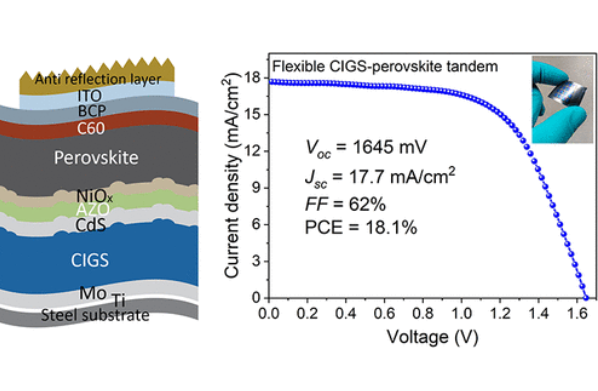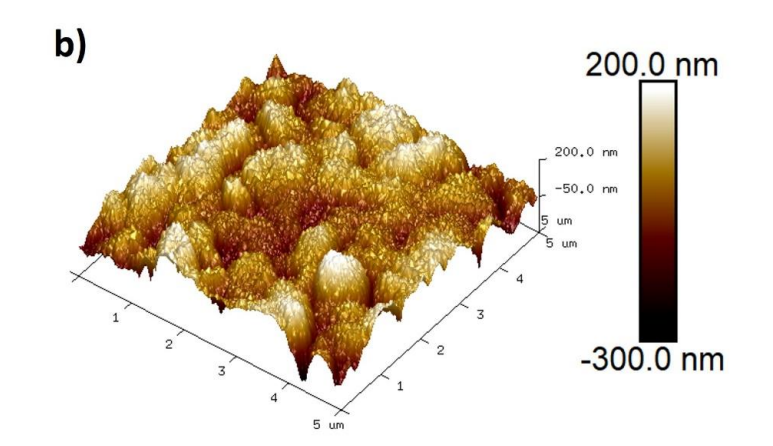
Researchers at the University of Sydney have made a significant leap forward in solar cell technology by achieving the highest efficiency reported to date for a perovskite-CIGS tandem solar cell built on a flexible steel substrate. This innovative design boasts a record-breaking 18.1% power conversion efficiency, paving the way for a new generation of adaptable and highly efficient solar panels.
The Power of Perovskite and CIGS:
The key to this achievement lies in the marriage of two promising thin-film solar cell technologies: perovskite and CIGS (copper, indium, gallium, and selenium). Perovskite solar cells have garnered significant attention in recent years due to their potential for high efficiency and low-cost fabrication. CIGS cells, on the other hand, offer established performance and stability. Combining these technologies in a tandem configuration allows researchers to leverage the strengths of each material, pushing the boundaries of solar cell efficiency.
The surface topology under the tilted view of the CIGS bottom cell measured by atomic force microscopy (AFM).

Schematic of the solar cell showing the layers - the research group built the cell with a 50 μm thick steel substrate coated with molybdenum (Mo), a CIGS absorber, a cadmium sulfide (CdS) window layer, transparent conductive oxide films made of aluminum-doped zinc oxide (AZO), a hole transport layer (HTL) based on nickel (II) oxide (NiO), a perovskite absorber, an electron transport layer (ETL) relying on buckminsterfullerene (C60), a spacer based on phenyl-C61-butyric acid (PCB), an indium tin oxide (ITO) layer, and an anti-reflection layer.

Perovskite research at the University of Sydney extends beyond tandem cells. Here are some recent advancements:
- Improved Stability: One of the major challenges with perovskite materials is their degradation over time. A research team led by Professor Martin A. Green at the University of Sydney made significant progress in this area. In a study published in Nature Energy, they demonstrated a perovskite solar cell with a remarkable operational lifetime exceeding 1,000 hours under continuous one-sun illumination while maintaining over 80% of its initial efficiency. This achievement was attributed to the incorporation of a specific interface modification layer that suppressed degradation pathways within the perovskite material.
- Perovskite-Silicon Tandem Cells: While perovskite-CIGS tandems offer high efficiencies, researchers are also exploring the potential of combining perovskite with silicon, the dominant material in solar cells today. A team at the University of Sydney, in collaboration with researchers from Korea, achieved a 25.5% efficiency perovskite-silicon tandem cell. This research highlights the ongoing exploration of various tandem configurations to achieve even higher efficiencies.
Steel as a Game Changer:
The groundbreaking aspect of this research extends beyond the materials used. Traditionally, solar cells rely on rigid glass substrates. However, the University of Sydney team has successfully utilized a flexible steel substrate. This innovation offers several advantages:
-
Lightweight and Adaptable: Steel substrates are significantly lighter than glass, making them ideal for applications where weight is a concern. Additionally, the flexibility allows for curved or roll-up solar panels, perfect for rooftops with unconventional shapes or integration into building facades.
-
Cost-Effective: Steel is a readily available and relatively inexpensive material compared to high-purity glass required for traditional solar cells. This reduction in material cost can significantly impact the overall affordability of the technology.
-
Conductive Properties: The use of steel offers a unique benefit. Since steel is conductive, it can act as both a substrate and an electrode for the solar cell. This eliminates the need for additional electrodes, simplifying the cell structure and potentially reducing production costs.
Building on Previous Success:
This record-breaking achievement is not the first success story for the University of Sydney's CIGS research team. In August 2023, another research group from the university presented a highly efficient 17.1% perovskite device. The current tandem cell design builds upon this earlier work, demonstrating the university's ongoing commitment to pushing the boundaries of solar cell technology.
CIGS Research Beyond the University of Sydney:
The University of Sydney is not alone in its pursuit of advancements in CIGS technology. Here are some recent developments from around the world:
-
Efficiency Records: First Solar, a leading CIGS manufacturer, collaborated with Uppsala University in Sweden to achieve a world record efficiency of 23.64% for a single-junction CIGS solar cell. This research demonstrates the ongoing improvement in efficiency for traditional CIGS technology.
-
Perovskite-CIGS Integration Challenges: While perovskite-CIGS tandems offer high potential, there are challenges associated with integrating these materials. Researchers at Helmholtz-Zentrum Berlin (HZB) in Germany identified a key factor affecting performance at the interface between the perovskite and CIGS layers. This research highlights the importance of addressing interfacial issues to unlock the full potential of perovskite-CIGS tandems.
-
Large-Scale Manufacturing: A significant barrier to widespread adoption of CIGS technology is the lack of established high-throughput manufacturing processes. Researchers at the National Renewable Energy Laboratory (NREL) in the United States are exploring innovative techniques, such as co-evaporation, to enable large-scale production of high-quality CIGS solar cells.
You can read more about the University of Sydney's great work in their most recent publication here, "Efficient Flexible Monolithic Perovskite–CIGS Tandem Solar Cell on Conductive Steel Substrate" -> https://pubs.acs.org/doi/full/10.1021/acsenergylett.4c00432
If you're excited by rooftop solar PV and want to take the next step for your place, request a Pure Electric get a free quote here -> https://pure-electric.com.au/getafreequote

